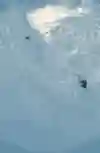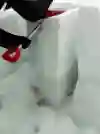Snowboarding
This winter in Europe has been treacherous; the snowpack is a ticking timebomb. What’s happening?
This winter’s snow in Europe has been particularly treacherous for skiers. After two magnificent winters, especially the last with record snow dumps, this winter’s snow pack is a ticking bomb waiting to explode at every turn. What’s happening under our skis then?
This winter’s snow pack is a ticking bomb waiting to explode at every turn.
“Smells dodgy,” said freerider Romain Grojean two weeks ago, overlooking a beautiful couloir in Les Arcs. This classic line is usually a must-do for freeriders, but it has been a minefield since the beginning of the season. And the recent snowfalls haven’t radically changed the situation. More snow, more windswept snow deposited on an unstable layer: a recipe for disaster.
“In November, we had only a thin layer of snow. And this layer was subjected to strong metamorphosis. The compact snowflakes turned into round balls without cohesion. A fragile layer that feels like sand or sugar,” explained Alain Duclos: guide, ski patroller and one of the best snow specialists in France.
The compact snowflakes turned into round balls without cohesion. A fragile layer that feels like sand or sugar.
After a good start in November, winter came to a halt as a warm spell of weather hit the continent. Nicolas Hale-Woods is the Freeride World Tour organiser, and his event series is directly affected by weather patterns. He recalls what happened: “We had snow in early November, it was good, but then we had a whole month without precipitation and the surface of the snow transformed into a sugar-like consistency.
Fresh snow fell on an unstable snow layer that you could compare to ball bearings and that explains the deadly accidents.
Then, fresh snow fell on an unstable snow layer that you could compare to ball bearings and that explains the deadly accidents. For example, it snowed in Courmayeur before the FWT event, then we had Foehn (warm southern wind) and strong temperature variations that damaged the cohesion of the snow pack.”
“Add high winds blowing North and South to the equation and you have dangerous North-facing and South-facing slopes, a high level of risk everywhere. As soon as there is new snow on a slope steeper than 30°, there is a risk. No need to tell you that you have to be very, very careful,” adds Alain Duclos.
As soon as there is new snow on a slope steeper than 30°, there is a risk. No need to tell you that you have to be very, very careful.
The situation is so dangerous that a Swiss website reported seven avalanche victims in five days – most of them during moderate avalanche danger ratings of 3-5.
Pro riders such as Géraldine Fasnacht, Anne-Flore Marxer, Dominique Perret and Xavier de le Rue declared they would be staying firmly on groomed slopes, or leaving the Alps altogether in search of safer riding zones.
Watch how freeskier Andrea Binning narrowly survived an avalanche:
In the past week or so, the situation has slightly improved, but high caution is still required. Recent snowfall has added to the stability of the snow pack, for example in Tyrol or the Southern Alps, where the snowpack is about two metres thick.
The situation has slightly improved, but high caution is still required. It's still really complex; there are still traps, but you never know where.
Tony Lamiche is a famous guide in the freeriding community. He’s been walking on eggshells since the beginning of the season, but finally feels things are a bit safer now: “The low layers now have more cohesion, thanks to new snow above pushing those lower layers to stick together. But the situation is really complex; there are still traps, but you never know where. You can find good powder runs but you have to know the local situation really well. There is no general rule of thumb this winter. Every run is different.”
Watch Xavier De Le Rue in the biggest avalanche ever:
So, if you go riding in the backcountry, don’t forget the key safety measures: Talk to the local mountain guides or freeriders first, check the official avalanche risk level, take a beacon/probe/shovel (and know how to use them!), if possible use an avalanche backpack, keep a safety distance (no less than 50 meters), know where you are going and don’t stop in exposed spots.
Talk to the local mountain guides or freeriders first...
Some of the videos here show enormous avalanches, but even a smaller one like in the top image can drag you down, cover you up – and 20 cm of compact snow is enough to immobilise you completely. Imagine having heavy cement poured on you...
Check out avalanche education lessons before even considering venturing off-piste. Here are some organisations that offer free avalanche awareness classes – make sure you sign up early enough.
Ortovox Safety Academy – free camps across Europe



